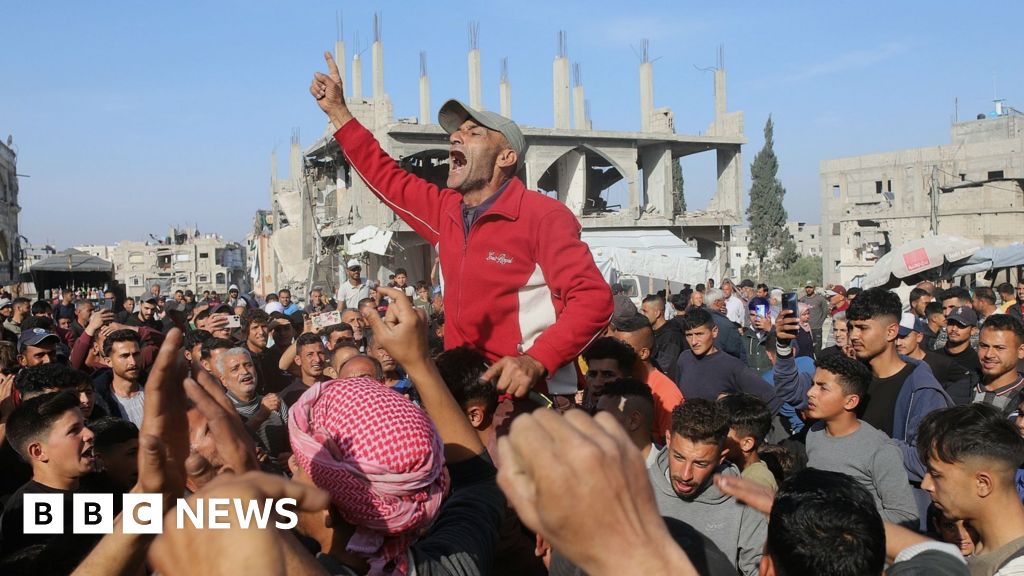BBC News, Jerusalem
“Out! Out! Out!”
The voice in the Telegram video is insistent. Loud. Sometimes musical.
And the message unambiguous.
“All of Hamas, out!”
On the streets of Gaza, more and more Palestinians are expressing open defiance against the armed group that’s ruled the strip for almost 20 years.
Many hold Hamas responsible for plunging the tiny, impoverished territory into the worst crisis faced by Palestinians in more than 70 years.
“Deliver the message,” another crowd chants, as it surges through Gaza’s devastated streets: “Hamas is garbage.”
“The world is deceived by the situation in the Gaza Strip,” says Moumen al-Natour, a Gaza lawyer and former organiser of the 2019 anti-Hamas “We Want to Live” movement.
Al-Natour spoke to us from the shattered remains of his city, the flimsy canvas side of the tent which now forms part of his house billowing behind him.
“The world thinks that Gaza is Hamas and Hamas is Gaza,” he said. “We didn’t choose Hamas and now Hamas is determined to rule Gaza and tie our fate to its own. Hamas must retreat. “
Speaking out is dangerous. Hamas has never tolerated dissent. Al-Natour seems undaunted, writing a furious column for the Washington Post at the end of March.
“To support Hamas is to be for Palestinian death,” he wrote, “not Palestinian freedom”.
Wasn’t it dangerous to speak out in this way, I asked him.
“We need to take a risk and speak out,” he replied without hesitation.
“I’m 30 years old. When Hamas took over, I was 11. What have I done with my life? My life has been wasted between war and escalating violence for nothing.”
Since Hamas took control of Gaza in 2007 by violently ousting political rivals, a year after winning national elections, there have been three major wars with Israel and two smaller conflicts.
“Humanity demands that we raise our voices,” al-Natour said, “despite suppression by Hamas”.
Hamas may be busy fighting Israel, but it’s not afraid to punish its critics.
At the end of March, 22-year old Oday al-Rubai was abducted by armed gunmen from a refugee shelter in Gaza City.
Hours later, his body was found covered in horrific wounds.
The Palestinian Independent Commission for Human Rights said Oday had been tortured, calling his death “a grave violation of the right to life and an extrajudicial killing”.
Al-Rubai had participated in recent anti-Hamas protests. His family blamed Hamas for his death and demanded justice.
Days earlier, a frightened al-Rubai posted a dark, grainy video on social media in which he expressed his fear that Hamas militants were coming for him.
“Gaza has become a city of ghosts,” he said, glancing over his shoulder.
“I’m stranded in the street, not knowing where to go. I don’t know why they’re after me. They destroyed us and brought ruin to us.”
At his funeral, a small crowd demanded revenge and repeated demands for Hamas to get out of Gaza.
Last summer, Amin Abed almost suffered the same fate, following his decision to speak out against Hamas.
Masked militants beat him senseless, broke bones all over his body and damaged his kidneys. Abed survived but had to seek medical treatment abroad.
Now living in Dubai, he’s still involved in the protest movement, and believes that Hamas’ authority is diminished.
“Hamas’ power has begun to fade,” he told me.
“It targets activists and civilians, beats and kills them to scare people. But it’s not how it was before.”
Before the ceasefire collapsed last month, Hamas fighters seemed intent on highly visible displays of power.
But now, with Israel once again attacking relentlessly, the same gunmen have retreated underground and Gaza’s civilians have been plunged back into the misery of war.
Some of the more recent protests suggest that civilians, driven to the edge of madness by a year and a half of Israeli bombardment, are losing their fear of Hamas.
Beit Lahiya, at the northern end of the Gaza Strip, has seen some of the most vociferous opposition.
In a series of voice notes, an eyewitness – who asked not to be named – described several recent incidents in which local residents prevented Hamas fighters from carrying out military actions from inside their community.
On 13 April, he said, Hamas gunmen tried to force their way into the house of an elderly man, Jamal al-Maznan.
“They wanted to launch rockets and pipes [a derogatory term used for some of Hamas’ home-made projectiles] from inside his house,” the eyewitness told us.
“But he refused.”
The incident soon escalated, with relatives and neighbours all coming to al-Maznan’s defence. The gunmen opened fire, injuring several people, but eventually were driven out.
“They were not intimidated by the bullets,” the eyewitness said of the protesters.
“They advanced and told [the gunmen] to take their things and flee. We don’t want you in this place. We don’t want your weapons that have brought us destruction, devastation and death.”
Elsewhere in Gaza, protesters have told militants to stay away from hospitals and schools, to avoid situations in which civilians are caught up in Israeli air strikes.
But such defiance is still risky. In Gaza City, Hamas shot one such protester dead.
With little to lose and hopes of an end to the war dashed once more, some Gazans direct their fury equally at Israel and Hamas.
Asked which side he blamed most for Gaza’s catastrophe, Amin Abed said it was “a choice between cholera and the plague”.
The protest movement of recent weeks is not yet a rebellion, but after almost 20 years of rule Hamas’ iron grip on Gaza is slowly slipping.
#Hamas #iron #grip #Gaza #slowly #slipping #residents #protest
latest news today, news today, breaking news, latest news today, english news, internet news, top news, oxbig, oxbig news, oxbig news network, oxbig news today, news by oxbig, oxbig media, oxbig network, oxbig news media
HINDI NEWS
News Source

